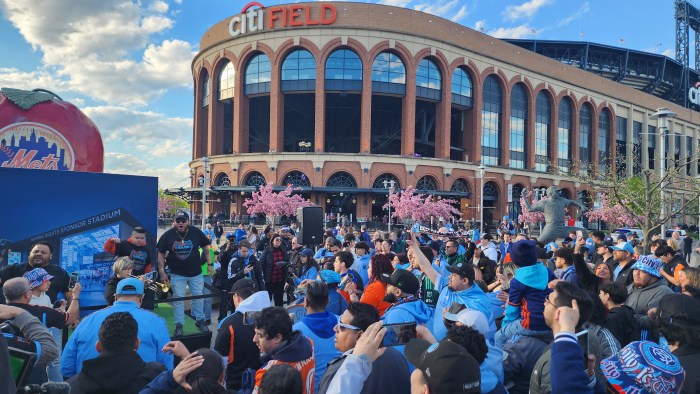Alexandros Washburn likes to talk to people before planning their buildings.
That wasn’t always the norm. The Bloomberg administration’s chief urban designer and professor of resiliency at the Stevens Institute of Technology cut his teeth as a staffer for U.S. Sen. Daniel Patrick Moynihan in the early ’90s. Washburn says he heard stories from Moynihan, who remembered seeing New York’s titan of construction, Robert Moses, in action.
Moses would go into Gov. Averell Harriman’s office with a list of projects written on a manila envelope. He’d fold his arms and scowl, hand the envelope to the governor, and then leave.
“That was planning,” Washburn says.
That kind of top-down approach — and also the large scale — was on display this week when global developers AECOM unveiled its “framework” for the future of Red Hook, a grand and already controversial vision for a part of Brooklyn ripe for change.
Something’s coming to Red Hook, that much is undeniable.
A transit-isolated, seaside neighborhood that boomed and busted with the shipping industry, Red Hook is now home to artists, families, and the biggest New York City Housing Authority development in the borough. There’s also lots of underutilized land — some owned by the city, some by the Port Authority.
The AECOM proposal makes use of that land and then some. The centerpiece is an expansion of the 1 train to Brooklyn, with three stops from Red Hook to Sunset Park. Around those stops, massive development — one scenario calls for just under 50,000 units, 25 percent of them “affordable,” plus manufacturing space that could add new jobs.
The futuristic renderings depict an “activated waterfront” with parks and public spaces (think Battery Park City). Berms and flood gates around the Gowanus Canal would offer flood resilience. A “rambla” would connect NYCHA’s Red Hook Houses to the waterfront. Cue picture of children happily racing past chic designer wooden benches.
AECOM’s model incorporates another bold dream: The proposed BQX streetcar, which Mayor Bill de Blasio hopes will connect Brooklyn and Queens’s waterfront.
Show me the money
The funding scheme, however, is shaky. Even the largest variant of AECOM’S “framework” wouldn’t pay for the marquee project — the subway — itself, requiring “other sources of funding.” And the report’s estimate for the tunnel and three stations — $3.5 billion — seems low when compared to the $2.42 billion pricetag for a measly one-stop extension of the 7 train that opened last year.
The AECOM plan doesn’t call for a subway stop on Governor’s Island, a no-brainer if you’re really looking to think big and “activate” underused land.
Which all makes clear that it’s not really about the subway, a boon that most Red Hook residents would love. It’s about that funny thicket of buildings cropping up on renderings mirroring Lower Manhattan — the skyscrapers.
Washburn calls the plan “circular logic” — that you want a subway, and the only way to get it is high rises on the water. It’s “a solution so dull that Robert Moses would be ashamed.”
Washburn, a veteran of the Hudson Yards project and High Line expansion, is no foe of development. He says Red Hook needs attention in the form of housing, transit and (above all) storm resiliency, but attacking those issues luxury-condo-first is not the solution.
But that’s the kind of hammer you use for this nail when you’re imposing plans, not soliciting advice. AECOM freely admits that they didn’t consult locals before the big unveiling — its plan is just meant to start the discussion.
“Why was the meeting not held in Red Hook?” asks Jill Eisenhard, a Red Hook advocate who was on the panel at NYU where AECOM’s chief executive unveiled the framework. She was surprised at the extent of what is in fact, if not name, a major proposal. Why not present the ideas to locals and those interested in the area on site? Instead, the panel discussion was in Manhattan.
There’s another way
Bottom-up planning, in contrast, might lead to less disruptive, more consequential development, avoiding blunt tools that have unforeseen consequences — like the nearby Moses-era Gowanus Expressway, which continues to cut the neighborhood off from the rest of Brooklyn.
The question, though, is whether the powers that be — the developers and the political leaders who need to court them — will be so gung-ho about community plans.
Washburn, a 10-year resident of Red Hook who stayed during Superstorm Sandy to investigate the storm surge, is working on his own ideas for the neighborhood: Block-by-block, his plan focuses on raising and flood proofing buildings and putting manufacturing or business space on ground floors. Housing and more office space could go above, though not Manhattan-style floors and floors of it.
Can that kind of approach be expansive enough to fund a subway, or fully withstand rising flood waters?
Washburn says it should.
Red Hook’s residents are just a few of the “one billion people in the world who live within one meter of current sea level.” Similarly low-lying areas worldwide are less enticing to global capital. That doesn’t mean they shouldn’t get a chance at preservation and expansion.
“The solutions here,” Washburn says, “can be used around the world.”

















